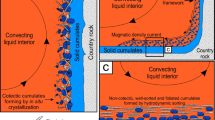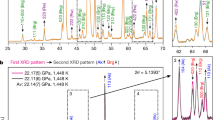Abstract
The 700-km seismic discontinuity which defines the top of the Earth's lower mantle is generally attributed to the transformation of the upper mantle (Mg, Fe)2 SiO4 spinel into magnesiowüstite (Mg, Fe)O and (Mg, Fe)SiO3 with perovskite structure1. Large-volume high-pressure experiments2 have provided important thermodynamical information on this transition, but its mechanisms and kinetics are still unknown. Here we report microstructural observations of the products of the transformation of (Mg, Fe)2SiO4 olivine and spinel and Ca2GeO4 olivine, effected in a laser-heated diamond anvil cell (DAC). The observations were made by transmission electron microscopy (TEM), a technique that has already proved useful in investigating the olivine-spinel transition in the DAC3,4. We find that, in all cases, the transformed product has a eutectoid-like appearance (as in pearlitic carbon steels), with alternating lamellae of the rock salt and perovskite phases. The thickness and spacing of the lamellae increase with temperature until a granular structure forms. These observations suggest that the transformation starts as a eutectoid transformation, whose physical mechanisms might be as effective in the Earth's mantle as in the DAC.
This is a preview of subscription content, access via your institution
Access options
Subscribe to this journal
Receive 51 print issues and online access
$199.00 per year
only $3.90 per issue
Buy this article
- Purchase on Springer Link
- Instant access to full article PDF
Prices may be subject to local taxes which are calculated during checkout
Similar content being viewed by others
References
Liu, L. in The Earth: its Origin, Structure and Evolution (ed. McElhinny, M. W.) 177–202 (Academic, New York, 1979).
Ito, E. & Yamada, H. in High Pressure Research in Geophysics (eds Akimoto S. & Manghnani, M. H.) 405–419 (Reidel, Dordrecht, 1982).
Lacam, A., Madon, M. & Poirier, J. P. Nature 288, 155–157 (1980).
Boland, J. N. & Liu, L. Nature 303, 233–235 (1983).
Peyronneau, J., Madon, M. & Poirier, J. P. J. Phys. 45, C8403–404 (1984).
Putnis, A. & Price, G. D. Nature 280, 217–218 (1979).
Madon, M. & Poirier, J. P. Science 207, 66–68 (1980).
Doherty, R. D. in Physical Metallurgy (eds Cahn, R. W. & Haasen, P.) 996–1004 (North-Holland, Amsterdam, 1983).
Hornbogen, E. Metall. Trans. 3, 2713–2727 (1972).
Fournelle, R. A. & Clark, J. B. Metall. Trans. 3, 2757–2767 (1972).
Puls, M. P. & Kirkaldy, J. S. Metall. Trans. 3, 2777–2796 (1972).
Livingston, J. D. & Cahn, J. W. Acta Metall. 22, 495–503 (1974).
Sundquist, B. E. Acta Metall. 16, 1413–1427 (1968).
Reid, A. F. & Ringwood, A. E. J. Solid State Chem. 1, 557–565 (1970).
Liu, L. Phys. Earth planet. Inter. 17, P29–33 (1978).
Madon, M. thesis, Univ. Paris (1986).
Author information
Authors and Affiliations
Rights and permissions
About this article
Cite this article
Poirier, J., Peyronneau, J., Madon, M. et al. Eutectoid phase transformation of olivine and spinel into perovskite and rock salt structures. Nature 321, 603–605 (1986). https://doi.org/10.1038/321603a0
Received:
Accepted:
Issue Date:
DOI: https://doi.org/10.1038/321603a0
This article is cited by
Comments
By submitting a comment you agree to abide by our Terms and Community Guidelines. If you find something abusive or that does not comply with our terms or guidelines please flag it as inappropriate.



